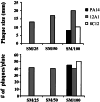The human pathogen Pseudomonas aeruginosa utilizes conserved virulence pathways to infect the social amoeba Dictyostelium discoideum
- PMID: 11867744
- PMCID: PMC122489
- DOI: 10.1073/pnas.052704399
The human pathogen Pseudomonas aeruginosa utilizes conserved virulence pathways to infect the social amoeba Dictyostelium discoideum
Abstract
Genetically accessible host models are useful for studying microbial pathogenesis because they offer the means to identify novel strategies that pathogens use to evade immune mechanisms, cause cellular injury, and induce disease. We have developed conditions under which the human pathogen Pseudomonas aeruginosa infects Dictyostelium discoideum, a genetically tractable eukaryotic organism. When D. discoideum is plated on nutrient agar plates with different P. aeruginosa strains, the bacteria form lawns on these plates with amoebae embedded in them. Virulent P. aeruginosa strains kill these amoebae and leave an intact bacterial lawn. A number of P. aeruginosa mutants have been identified that are avirulent in this assay. Amoebae feed on these bacteria and form plaques in their bacterial lawns. One avirulent mutant strain carries an insertional mutation in the lasR gene. LasR is a transcription factor that controls a number of virulence genes in a density-dependent fashion. Another class of avirulent P. aeruginosa mutants is defective in type III secretion. One mutant lacks the PscJ protein, a structural component of the secretion apparatus, suggesting that cytotoxins are injected into the D. discoideum cell. One of these cytotoxins is ExoU, and exoU mutants are avirulent toward D. discoideum. Complementation of the lasR and exoU mutations restores virulence. Therefore, P. aeruginosa uses conserved virulence pathways to kill D. discoideum.
Figures






References
-
- Deretic V. In: Persistent Bacterial Infections. Nataro J P, Blaser M J, Cunningham-Rundles S, editors. Washington, DC: Am. Soc. Microbiol.; 2000. pp. 305–326.
-
- Singh P K, Schaefer A L, Parsek M R, Moninger T O, Welsh M J, Greenberg E P. Nature (London) 2000;407:762–764. - PubMed
-
- Mahajan-Miklos S, Rahme L G, Ausubel F M. Mol Microbiol. 2000;37:981–988. - PubMed
-
- Kessin R H. Dictyostelium—Evolution, Cell Biology, and the Development of Multicellularity. Cambridge, U.K.: Cambridge Univ. Press; 2001.
Publication types
MeSH terms
Substances
Grants and funding
LinkOut - more resources
Full Text Sources
Other Literature Sources

